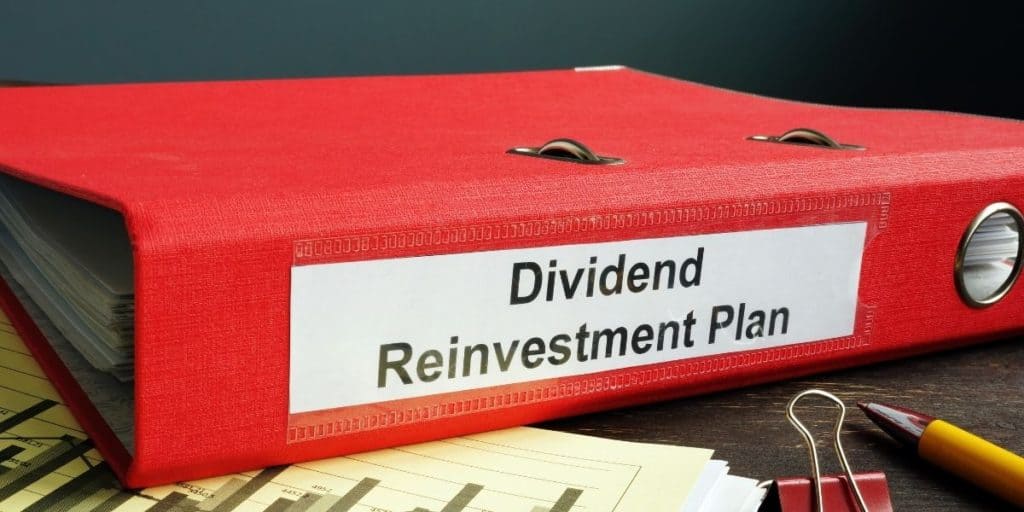Is dividend investing part of your investment mantra? Are you interested in earning dividends off your index funds investments? If you answered yes to any of these questions, you’ll want to understand the subtle nuances of dividend payment and reinvestment associated with index funds. Not every index fund will have the option for you to get or reinvest dividends, but you must take full advantage of it when you can.
Index fund investors can either have dividends paid to them or reinvested into the same fund to buy more shares. Dividend reinvestment is fully automatic and allows one to fully benefit from compounded growth. It is therefore the recommended option for most investors.
In short, you can reinvest the dividends back into index fund shares or withdraw them. Most of the time, it’s a better strategy to have this happen automatically. However, there are cases where you’ll want to withdraw the dividends on your own. Read on to learn more about how dividend reinvestment works with index funds and the situations where you may want to withdraw dividends.
IMPORTANT SIDENOTE: I surveyed 1500+ traders to understand how social trading impacted their trading outcomes. The results shocked my belief system! Read my latest article: ‘Exploring Social Trading: Community, Profit, and Collaboration’ for my in-depth findings through the data collected from this survey!
Table of Contents
How To Reinvest Dividends in Index Funds?
Dividend reinvestment is an excellent and efficient way to grow your income even further with an index fund portfolio. The money earned automatically goes back into the shares, giving you the full benefits of compounding.

Some investors will wait while they accumulate dividends. Then, when the market drops, they buy more shares at a lower price. This option works well if you know how to time the market. However, many new investors choose to have the dividends reinvested automatically.
The fund management company often provides this service without any extra cost to you. To participate, you may need to contact your broker. Once you do, they’ll set you up to automatically reinvest into the company.
For anyone new to index funds investing, I highly recommend reading the book Von Clyde Index Fund Investing (available on Amazon.com). The guide covers everything about index funds, including how they work, why you should invest in them, how to buy an index fund, and what to consider when choosing which index fund to buy. It’s an excellent read for any beginner to learn more about growing their income using index funds.
Why Consider Reinvesting Index Fund Dividends?
There are a ton of reasons for which you should reinvest your dividends. It’s a pretty simple process to set up, and with it, your money grows even faster. This feature comes from the principle of compoundinging.
When you reinvest dividends, they start to earn interest too. The more time that goes by, the more returns you make. For example, say you invest $10,000 with compounding return at 10%. After ten years, you’ll have $25,937.
If you only had a simple interest rate, you’d have $20,000 after ten years. If you wait longer, the difference between simple and compound return continues to grow. For example, your $10,000 would grow to $174,000 after a total of 30 years. However, with simple interest, you’d only have $40,000 after those same 30 years.
In short, compounding is almost always the way to go! You can quickly achieve this type of interest by reinvesting your dividends. The more time you allow to pass, the more you can earn off of the compounding effect.
When You Should Withdraw Index Fund Dividends?
You want to reinvest all your dividends in most cases. When you have a strong portfolio, you’ll have more benefits from reinvesting than if you were to withdraw the money. Funds that automatically reinvest the dividends grow at a much faster rate.
However, there are still instances where you should withdraw the dividends. If the investment fund isn’t doing well and shows signs of low or maybe negative returns, you’ll want to take the dividends. Then, you can reinvest them somewhere they can make a higher income.
Overall, you’ll need to assess where the dividends come from carefully. When they come from a growing fund that generates expected returns, make sure to reinvest them. On the other hand, if a fund is showing signs of struggle, it may not be the brightest idea to continue reinvesting in the same fund – at least, until the fund starts to recover.
Do You Pay Taxes on Reinvested Dividends?
The government does tax dividends that you earn during the year. Many people expect this when they withdraw their dividends. However, many investors are unsure about whether or not they need to pay taxes on reinvested dividends.
You’ll need to pay taxes on reinvested dividends. All dividends you earn from your index fund must factor into your taxes for the year you received them. This rule is valid, even when you reinvest all of your dividend earnings.
As a result, you must keep track of all your dividends, whether you decide to reinvest them back into the shares or not. That way, you can feel more prepared come tax time, and there are no surprises for you!
The Dividend Reinvestment Tax
Tax rates will vary depending on whether the dividends are qualified or non-qualified. Moreover, your taxable income also comes into play. These rates on qualified dividends are either 0%, 15%, or 20%. With non-qualified dividends, the rate should be the same as the one for your tax bracket, which can fall between 10% and 37%.
If you’re withdrawing the dividends, make sure you set aside enough to cover the tax payment due at the end of the year. The IRS always treats dividends as though you had withdrawn them, even if you reinvested them.
However, if the company gives you more company shares, these aren’t taxable until you sell the stock for money. It’s worth always considering what taxes you need to pay, so make sure you ask the broker if you’re feeling confused.
Reducing Reinvestment Tax
Is it possible to lessen the amount of reinvestment tax you need to pay on dividends? Yes. You can use tax-shielded accounts, such as the Roth IRA. These options are best for anyone who needs to save for retirement.
Since you contribute money that’s already taxed, you won’t need to pay again unless you withdraw the money earlier than you’re supposed to.
How To Automate the Dividend Reinvestment Process?
There are plenty of ways to reinvest your dividends automatically. The most straightforward way is to set up an automatic reinvestment plan, or DRIP. You can ask your stock broker or fund manager about it or even set it up for individual stocks (not just diversified investments like index funds).
When you automate the reinvestment process, you have access to more compound returns. Over time, this compound returns can add up to a high income, just from your dividends!
Many brokers offer the DRIP feature, so make sure you discuss it with yours. Some DRIPs only allow you to reinvest in fractional shares, while others provide you with whole shares.
Additionally, it’s best to remember that your broker may also charge a commission for every reinvestment. While not everyone will charge you more for this feature, it’s still a good idea to ask about commission fees when you have concerns.
Overall, it’s relatively simple to automate the process. If you invest with an online broker, odds are they already reinvest the dividends for you—for free! Nevertheless, make sure you look into the broker’s policies, as all places have different rules.
Author’s Recommendations: Top Trading and Investment Resources To Consider
Before concluding this article, I wanted to share few trading and investment resources that I have vetted, with the help of 50+ consistently profitable traders, for you. I am confident that you will greatly benefit in your trading journey by considering one or more of these resources.
- Roadmap to Becoming a Consistently Profitable Trader: I surveyed 5000+ traders (and interviewed 50+ profitable traders) to create the best possible step by step trading guide for you. Read my article: ‘7 Proven Steps To Profitable Trading’ to learn about my findings from surveying 5000+ traders, and to learn how these learnings can be leveraged to your advantage.
- Best Broker For Trading Success: I reviewed 15+ brokers and discussed my findings with 50+ consistently profitable traders. Post all that assessment, the best all round broker that our collective minds picked was M1 Finance. If you are looking to open a brokerage account, choose M1 Finance. You just cannot go wrong with it! Click Here To Sign Up for M1 Finance Today!
- Best Trading Courses You Can Take For Free (or at extremely low cost): I reviewed 30+ trading courses to recommend you the best resource, and found Trading Strategies in Emerging Markets Specialization on Coursera to beat every other course on the market. Plus, if you complete this course within 7 days, it will cost you nothing and will be absolutely free! Click Here To Sign Up Today! (If you don’t find this course valuable, you can cancel anytime within the 7 days trial period and pay nothing.)
- Best Passive Investment Platform For Exponential (Potentially) Returns: By enabling passive investments into a Bitcoin ETF, Acorns gives you the best opportunity to make exponential returns on your passive investments. Plus, Acorns is currently offering a $15 bonus for simply singing up to their platform – so that is one opportunity you don’t want to miss! (assuming you are interested in this platform). Click Here To Get $15 Bonus By Signing Up For Acorns Today! (It will take you less than 5 mins to sign up, and it is totally worth it.)

Conclusion
Overall, you’ll want to take advantage of reinvesting your dividends whenever you can. It’s easy to automate the process, so don’t hesitate to do it! The sooner you start reinvesting, the sooner you can begin to accumulate that compounding return.
Compounding is the most significant benefit that comes with reinvesting. It allows you to grow small amounts of funds into massive amounts of money—all you need is a lot of time! If you’re patient, you can quickly gather a ton of dividends for compound returns.
BEFORE YOU GO: Don’t forget to check out my latest article – ‘Exploring Social Trading: Community, Profit, and Collaboration’. I surveyed 1500+ traders to identify the impact social trading can have on your trading performance, and shared all my findings in this article. No matter where you are in your trading journey today, I am confident that you will find this article helpful!
Affiliate Disclosure: We participate in several affiliate programs and may be compensated if you make a purchase using our referral link, at no additional cost to you. You can, however, trust the integrity of our recommendation. Affiliate programs exist even for products that we are not recommending. We only choose to recommend you the products that we actually believe in.
